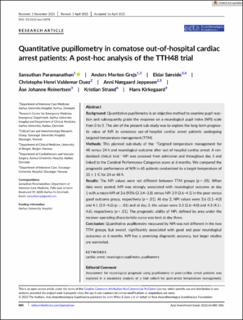| dc.contributor.author | Paramanathan, Sansuthan | |
| dc.contributor.author | Grejs, Anders Morten | |
| dc.contributor.author | Søreide, Eldar | |
| dc.contributor.author | Duez, Christophe Henri Valdemar | |
| dc.contributor.author | Jeppesen, Anni Nørgaard | |
| dc.contributor.author | Reinertsen, Åse Johanne | |
| dc.contributor.author | Strand, Kristian | |
| dc.contributor.author | Kirkegaard, Hans | |
| dc.date.accessioned | 2022-09-30T09:43:34Z | |
| dc.date.available | 2022-09-30T09:43:34Z | |
| dc.date.created | 2022-08-31T20:18:21Z | |
| dc.date.issued | 2022 | |
| dc.identifier.issn | 0001-5172 | |
| dc.identifier.uri | https://hdl.handle.net/11250/3022817 | |
| dc.description.abstract | Background: Quantitative pupillometry is an objective method to examine pupil reaction and subsequently grade the response on a neurological pupil index (NPi) scale from 0 to 5. The aim of the present sub-study was to explore the long-term prognostic value of NPi in comatose out-of-hospital cardiac arrest patients undergoing targeted temperature management (TTM).
Methods: This planned sub-study of the “Targeted temperature management for 48 versus 24 h and neurological outcome after out-of-hospital cardiac arrest: A randomized clinical trial.” NPi was assessed from admission and throughout day 3 and linked to the Cerebral Performance Categories score at 6 months. We compared the prognostic performance of NPi in 65 patients randomized to a target temperature of 33 ± 1°C for 24 or 48 h.
Results: The NPi values were not different between TTM groups (p > .05). When data were pooled, NPi was strongly associated with neurological outcome at day 1 with a mean NPi of 3.6 (95% CI 3.4–3.8) versus NPi 3.9 (3.6–4.1) in the poor versus good outcome group, respectively (p < .01). At day 2, NPi values were 3.6 (3.1–4.0) and 4.1 (3.9–4.2) (p = .01) and at day 3, the values were 3.3 (2.6–4.0) and 4.3 (4.1–4.6), respectively (p < .01). The prognostic ability of NPi, defined by area under the receiver operating characteristic curve was best at day three.
Conclusion: Quantitative pupillometry measured by NPi was not different in the two TTM groups, but overall, significantly associated with good and poor neurological outcomes at 6 months. NPI has a promising diagnostic accuracy, but larger studies are warranted. | en_US |
| dc.language.iso | eng | en_US |
| dc.publisher | Wiley | en_US |
| dc.title | Quantitative pupillometry in comatose out-of-hospital cardiac arrest patients: A post-hoc analysis of the TTH48 trial | en_US |
| dc.title.alternative | Quantitative pupillometry in comatose out-of-hospital cardiac arrest patients: A post-hoc analysis of the TTH48 trial | en_US |
| dc.type | Journal article | en_US |
| dc.type | Peer reviewed | en_US |
| dc.description.version | publishedVersion | en_US |
| dc.rights.holder | Copyright 2022 the authors | en_US |
| cristin.ispublished | true | |
| cristin.fulltext | original | |
| cristin.qualitycode | 1 | |
| dc.identifier.doi | 10.1111/aas.14078 | |
| dc.identifier.cristin | 2047729 | |
| dc.source.journal | Acta Anaesthesiologica Scandinavica | en_US |
| dc.source.pagenumber | 880-886 | en_US |
| dc.identifier.citation | Acta Anaesthesiologica Scandinavica. 2022, 66 (7), 880-886. | en_US |
| dc.source.volume | 66 | en_US |
| dc.source.issue | 7 | en_US |
